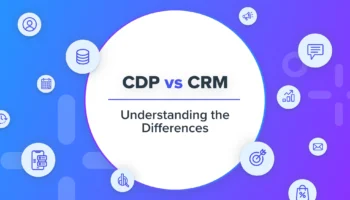We’ve been told the customer is always right. But are marketers really listening? Today’s consumers demand relevance, timeliness, and recognition at every turn. Forrester reveals that a mere 3% of businesses are genuinely “customer-obsessed.” What are the other 97% missing?
Customer Engagement Platforms (CEPs) offer a refreshing dose of clarity. A Customer Engagement Platform (CEP) transforms how businesses interact with their customers. It delivers personalized experiences consistently across all channels and centralizes every interaction and uses automation to tailor messages as your business grows. This matters now more than ever.
TL;DR:
Customer Engagement Platforms (CEPs) are essential for delivering personalized, AI-driven engagement at scale. Unlike CRMs, CEPs unify data, orchestrate omnichannel messaging, and automate intelligent customer journeys.
- Key Benefits: Real-time personalization, AI decisioning, automation, insights, and retention.
- Core Features: Unified CDP, omnichannel orchestration, AI actions, behavioral segmentation, testing tools, and integrations.
- Why it Matters: CEPs turn disconnected systems into seamless marketing engines focused on relevance and results.
Why Should You Care? What a CEP Helps You Do
Personalize at Scale: Tailor every interaction based on comprehensive customer data, making customers feel valued.
Ensure Consistency Across Channels: Keep your brand message unified across email, SMS, and social media, building stronger connections.
Automate Engagement: Save time and resources by automating routine tasks while keeping interactions personal, enhancing communication.
Gain Data-Driven Insights: Use real-time data to make smarter marketing decisions and optimize campaigns for better conversions.
Increase Retention Rates: Keep customers engaged and encourage long-term relationships.
Key Features of a Customer Engagement Platform (CEP)
So what exactly powers these outcomes? Let’s break down the key features that define a modern Customer Engagement Platform.
1. Unified Customer Data Platform (CDP)
Ingest and unify customer data from any source to build real-time, cross-device profiles.
Benefit: Enables deep understanding of behaviors and timely segmentation across audiences.
2. Omnichannel Orchestration
Coordinate seamless journeys across email, SMS, push, web, in-app, and paid media—adapting to customer behavior in real time.
Benefit: Creates consistent experiences no matter where a customer engages.
3. AI-Powered Decisioning
Use transparent, customizable AI to determine next-best actions, content, and timing.
Benefit: Drives personalization at scale while maintaining control and explainability. 86% of marketers using AI-driven recommendations report significantly lower acquisition costs, and 84% see improved recovery from lost conversions—proof that AI-powered personalization drives performance, not just engagement.
4. Behavioral Segmentation and Targeting
Group customers by intent, behavior, and preferences—automatically updating segments in real time.
Benefit: Ensures every message resonates with the right audience at the right moment.
5. Testing and Optimization Tools
Automate A/B testing, campaign winner selection, and performance optimization using data and AI.
Benefit: Continuously improve customer experiences with minimal manual effort.
6. Ecosystem Integration and Extensibility
Connect to CRM, support systems, data lakes, and other customer engagement tools through APIs or app hubs.
Benefit: Keeps your stack flexible while reducing redundancy.
Customer Engagement Platform vs CRM: What’s the Difference?
Customer Engagement Platforms (CEPs) and Customer Relationship Management (CRM) systems are both crucial, but they play different roles. Think of a CRM as your address book—it stores customer data and organizes interactions. A CEP, on the other hand, is the conversation—it uses that data to create personalized experiences in real time.
CRMs are designed to manage customer data, keeping records organized and accessible. CEPs, on the other hand, bring that data to life—activating it through AI-powered decisioning and omnichannel engagement to deliver timely, personalized experiences.
Together, they’re a powerful combination: the CRM organizes, and the CEP personalizes.
| Feature | CRM | CEP |
|---|---|---|
| Primary Focus | Data storage & relationship management | Real-time engagement & personalization |
| Core Function | Track customer history and interactions | Deliver cross-channel personalized experiences |
| Strength | Organizing structured customer records | Activating customer data for marketing and engagement |
| Integration | Streamlines sales and service workflows | Integrates personalization tools, AI engines, and omnichannel marketing |
| Purpose | Manage relationships and maintain customer records | Enhance engagement through personalization, automation, and real-time action |
Understanding these differences helps you maximize the value of both tools.
How AI Powers Customer Engagement Platforms
Artificial Intelligence is changing how customer engagement platforms work. It boosts their capabilities, making them smarter and more efficient. AI helps in understanding customer behavior and predicting what they need next. This means businesses can offer a more personalized experience, improving customer engagement.
Instead of just offering a list of AI-driven features, consider how AI fundamentally changes the game:
From Guesswork to Prediction: AI-powered predictive insights forecast customer needs and preferences, enabling businesses to deliver relevant content that resonates.
From Generic to Personalized: It uses customer data to recommend products or content tailored to individual interests, enhancing relevance and driving engagement.
From Reactive to Proactive: Real-time action suggestions provide instant recommendations on the best actions to take during customer interactions, ensuring every engagement is timely and impactful.
From Manual to Automated: Marketing decisions can be automated based on live behavioral signals, ensuring each message is timely and effective.
AI in Customer Engagement Platforms transforms the way businesses connect with their audience, creating a more personalized and effective customer journey.
How to Choose a Customer Engagement Platform (CEP)
Choosing the right Customer Engagement Platform (CEP) is a critical decision that can significantly impact your business’s success. It’s about finding a tool that not only fits your current needs but also scales with your growth and aligns with your strategic goals.
When evaluating CEPs, consider these key factors:
Scalability: Can the platform grow with your business as your customer base and engagement needs evolve?
Integration: Does it integrate seamlessly with your existing tech stack so you can evolve without rebuilding your foundation?
User-Friendliness: Is the platform intuitive and easy for your team to use, minimizing the learning curve and maximizing adoption?
Goal Alignment: Does the CEP support your specific engagement goals, such as increasing customer loyalty, driving revenue growth, or improving customer satisfaction?
Real-World Impact: Look for platforms that demonstrate proven results in your industry or use case. There are many customer engagement software solutions available, so choosing one that aligns with your business’s complexity and customer lifecycle is critical. For example, rental platform Zumper saw remarkable results after implementing a CEP with predictive recommendations and advanced personalization:
- 384% increase in lead submissions
- 198% increase in message volume
- 128% increase in click-through rates
By replacing a custom-built system that required significant engineering lift, they were able to scale dynamically and deliver tailored experiences to users in real time.
By carefully considering these factors, you can select a CEP that meets both your current and future needs, empowering you to build stronger customer relationships and achieve your business objectives.
Why Customer Engagement Platforms Are Essential for Growth
At the end of the day, it’s not about the technology; it’s about the people. Customer Engagement Platforms are simply a tool to help you build stronger, more meaningful relationships.
By breaking down silos between data, decisioning, and delivery, they empower teams to scale engagement, optimize performance, and build long-term loyalty. When you focus on truly understanding and connecting with your customers, the rest will follow.




